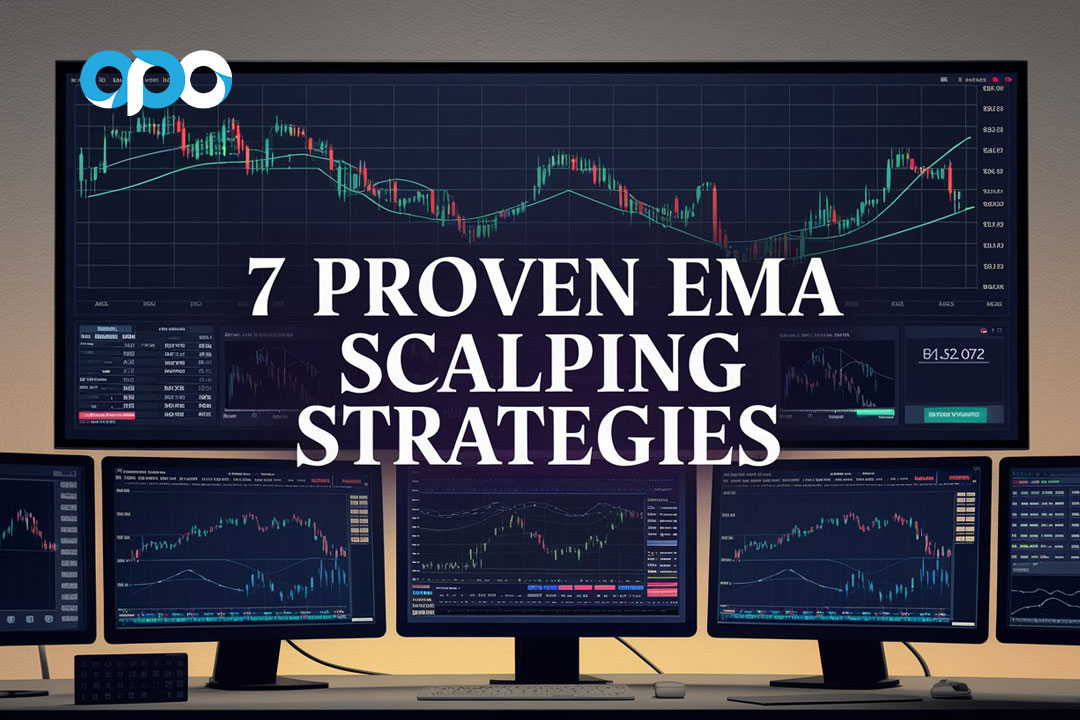The EMA scalping strategy is a powerful forex trading technique that uses Exponential Moving Averages to identify short-term trends and capture quick profits in the currency market. This comprehensive guide will reveal seven proven EMA scalping strategies, empowering you to make informed trading decisions and potentially increase your profitability in the fast-paced world of forex.

Whether you’re searching for the best EMA scalping strategy or looking to refine your existing approach, this article provides valuable insights for traders of all levels. We’ll explore seven effective EMA scalping techniques, discuss best practices, and offer expert tips to help you master this dynamic trading style.
For those new to forex trading, choosing the right online forex broker is crucial for implementing these strategies effectively. As we delve into the world of EMA scalping, you’ll discover how to leverage these powerful tools to potentially enhance your trading performance and achieve your financial goals.
Understanding EMA Scalping

What is EMA Scalping?
EMA scalping is a trading strategy that uses Exponential Moving Averages to identify short-term trends and potential entry and exit points. Scalpers aim to make numerous small profits from quick trades, often holding positions for just a few minutes or even seconds.
Why Use EMAs for Scalping?
- Quick responsiveness: EMAs react faster to price changes than simple moving averages, making them ideal for short-term trading.
- Trend identification: Multiple EMAs can help traders spot trend direction and strength.
- Support and resistance levels: EMAs often act as dynamic support and resistance, providing valuable entry and exit signals.
- Reduced lag: EMAs give more weight to recent price data, reducing lag compared to other indicators.
- Versatility: EMAs can be applied to various timeframes and combined with other technical tools.
Read More: MACD Indicator for Scalping
7 Proven EMA Scalping Strategies

1. The Classic 5/13 EMA Crossover
This strategy uses two EMAs: a fast 5-period EMA and a slower 13-period EMA.
- Entry: Buy when the 5 EMA crosses above the 13 EMA, sell when it crosses below.
- Exit: Use a fixed pip target or wait for an opposite crossover.
- Stop-loss: Place stops below recent swing lows for long trades, above swing highs for shorts.
Pro Tips:
- Use this strategy on lower timeframes (1-minute to 5-minute charts) for more frequent signals.
- Combine with support and resistance levels for higher probability trades.
- Consider using a trailing stop to lock in profits as the trade moves in your favor.
- Pay attention to the angle of the EMAs; steeper angles often indicate stronger trends.
Advanced Application:
- Implement a “zone” approach instead of exact crossovers. Enter trades when the fast EMA enters a zone around the slow EMA, potentially catching moves earlier.
- Use volume indicators to confirm the strength of the crossover signal.
2. Triple EMA Strategy
Combining three EMAs can provide more robust signals:
- Use 5, 13, and 50 period EMAs
- Entry: Look for all three EMAs to align in the same direction
- Confirmation: Wait for price to pull back to the fastest EMA before entering
- Exit: When price closes beyond the middle EMA in the opposite direction
Pro Tips:
- This strategy works well on 5-minute to 15-minute charts for scalping.
- Look for “fanning” of the EMAs, where they spread out in the direction of the trend, indicating a strong move.
- Use the 50 EMA as a trend filter; only take long trades above it and short trades below it.
Advanced Application:
- Experiment with different EMA periods to find the combination that works best for your chosen currency pairs and trading style.
- Incorporate momentum indicators like RSI or MACD to confirm the strength of the trend.
3. EMA with RSI Confirmation
Pair the EMA crossover with the Relative Strength Index (RSI) for added confirmation:
- Use 5 and 13 EMAs along with a 14-period RSI
- Entry: EMA crossover occurs while RSI is above 50 for buys, below 50 for sells
- Exit: When RSI crosses back over the 50 level in the opposite direction
Pro Tips:
- This strategy is effective on 1-minute to 5-minute charts for quick scalps.
- Look for RSI divergence as an early warning of potential trend reversals.
- Consider using extreme RSI levels (above 70 or below 30) for even stronger confirmation.
Advanced Application:
- Combine with price action patterns like pin bars or engulfing candles for high-probability setups.
- Use RSI trendlines to identify hidden momentum shifts.
4. EMA Ribbon Scalping
An EMA ribbon consists of multiple EMAs of different periods plotted on the same chart:
- Use EMAs from 5 to 50 periods (e.g., 5, 10, 15, 20, 25, 30, 35, 40, 45, 50)
- Entry: When price breaks through the ribbon in either direction
- Exit: When price touches the opposite side of the ribbon
Pro Tips:
- This strategy works well on 5-minute to 15-minute charts.
- The width of the ribbon can indicate trend strength; a wider ribbon suggests a stronger trend.
- Use the angle of the ribbon to gauge trend strength and potential reversals.
Advanced Application:
- Adjust the number and spacing of EMAs in your ribbon to suit different market conditions and volatility levels.
- Combine with Fibonacci retracement levels for precise entry and exit points.
5. EMA with Stochastic Oscillator
Combine EMAs with the Stochastic Oscillator for precision entries:
- Use 5 and 13 EMAs with a 5,3,3 Stochastic Oscillator
- Entry: EMA crossover occurs while Stochastic is oversold (below 20) for buys or overbought (above 80) for sells
- Exit: When Stochastic crosses back into neutral territory (between 20 and 80)
Pro Tips:
- This strategy is suitable for 1-minute to 5-minute charts.
- Look for Stochastic divergence as an additional confirmation signal.
- Use the %K and %D lines of the Stochastic for more precise entry and exit signals.
Advanced Application:
- Implement a “double stochastic” by using two Stochastic Oscillators with different settings for more robust signals.
- Combine with pivot points for key support and resistance levels.
6. EMA Channel Strategy
Create a channel using two EMAs to identify potential breakouts:
- Use 20 and 50 period EMAs
- Entry: When price breaks out of the channel formed by the two EMAs
- Stop-loss: Place stops just inside the opposite side of the channel
- Target: Use a risk-reward ratio of at least 1:1
Pro Tips:
- This strategy works well on 15-minute to 1-hour charts for slightly longer scalping trades.
- Look for narrowing of the channel as a potential sign of an impending breakout.
- Use the midpoint between the two EMAs as a potential profit-taking level.
Advanced Application:
- Combine with Bollinger Bands to identify periods of low volatility before breakouts.
- Use volume analysis to confirm the strength of the breakout.
7. EMA with Bollinger Bands
Combine EMAs with Bollinger Bands for a powerful mean reversion strategy:
- Use a 20 EMA with standard Bollinger Bands (20 period, 2 standard deviations)
- Entry: When price touches a Bollinger Band and the 20 EMA is pointing in the direction of the potential reversal
- Exit: When price reaches the opposite Bollinger Band or the 20 EMA
Pro Tips:
- This strategy is effective on 5-minute to 15-minute charts.
- Look for “squeeze” setups where the Bollinger Bands narrow, indicating potential explosive moves.
- Use the middle Bollinger Band (which is a simple moving average) in conjunction with the EMA for additional confirmation.
Advanced Application:
- Implement the “Bollinger Band Walk” technique, entering trades when price consistently touches or exceeds one band while respecting the EMA.
- Combine with the Relative Strength Index (RSI) for additional overbought/oversold confirmation.
Read More: 7 Best Time Frames for Scalping
Best Practices for EMA Scalping

- Risk Management: Never risk more than 1-2% of your account on a single trade. This is crucial for long-term survival in the volatile world of scalping. Use stop-losses religiously and consider implementing a daily loss limit.
- Practice on a Demo Account: Before risking real capital, spend significant time mastering your chosen strategy on a demo account. This allows you to refine your technique, understand the nuances of your chosen pairs, and build confidence without financial risk.
- Use Appropriate Timeframes: Most EMA scalping strategies work best on lower timeframes, typically 1-minute to 15-minute charts. However, always confirm the overall trend on higher timeframes to avoid trading against the dominant market direction.
- Mind the Spread: As a scalper, the spread can significantly impact your profitability. Choose a broker with tight spreads and consider the spread when setting your take-profit levels. Your profit target should always be greater than the spread.
- Stay Disciplined: Emotional control is paramount in scalping. Stick to your trading plan, avoid revenge trading after losses, and don’t let greed push you to hold trades longer than your strategy dictates. Remember, consistency is key in scalping.
Common Pitfalls to Avoid
- Overtrading: Don’t feel compelled to be in the market constantly. Quality setups are more important than quantity.
- Ignoring the broader trend: Scalping against the overall trend can be risky. Always be aware of the bigger picture.
- Neglecting risk-reward ratios: Ensure your potential profits outweigh your risks. A minimum 1:1 risk-reward ratio is recommended, but 1:1.5 or higher is preferable.
- Chasing the market: Wait for valid setups rather than jumping in impulsively. Patience is a virtue in trading.
- Failing to adapt: Markets change, so be prepared to adjust your strategy when needed. Regularly review and optimize your approach.
Psychological Aspects of EMA Scalping
Successful EMA scalping requires not only technical skills but also strong mental discipline. Here are some psychological tips to enhance your scalping performance:
- Maintain emotional control: Scalping can be intense, but it’s crucial to stay calm and rational.
- Develop patience: Wait for your strategy to generate valid signals rather than forcing trades.
- Accept losses: Understand that losses are part of trading and learn from them instead of being discouraged.
- Manage stress: Take regular breaks and practice stress-reduction techniques to maintain mental clarity.
- Build confidence: As you gain experience and see positive results, your confidence will grow, leading to better decision-making.
Read More: Unlock Profitable Trading with the 3 EMA Scalping Strategy
OpoFinance: Your Trusted Partner in Forex Scalping
When it comes to executing your EMA scalping strategy, choosing the right broker is crucial. OpoFinance, an ASIC-regulated forex broker, offers traders a secure and efficient platform for implementing their scalping techniques. With tight spreads, fast execution, and a user-friendly interface, OpoFinance provides the ideal environment for scalpers to thrive.

One standout feature of OpoFinance is its innovative social trading service, which allows traders to connect with and learn from experienced professionals. This can be particularly beneficial for those new to EMA scalping or looking to refine their strategies. Additionally, OpoFinance’s official listing on the MT5 brokers list ensures compatibility with one of the most popular trading platforms in the forex industry.
Safety and convenience are paramount at OpoFinance, with a wide range of secure deposit and withdrawal methods available to suit every trader’s needs. Whether you’re just starting out or looking to take your scalping to the next level, OpoFinance offers the tools and support necessary for success in the fast-paced world of forex trading.
Conclusion
Mastering EMA scalping strategies can open up a world of opportunities in the forex market. By combining the responsiveness of EMAs with sound risk management and disciplined execution, traders can potentially achieve consistent profits through short-term price movements. Remember, success in scalping requires practice, patience, and continuous learning.
As you embark on your EMA scalping journey, keep refining your approach and stay adaptable to changing market conditions. Utilize the seven strategies outlined in this guide as a starting point, but don’t be afraid to adapt and personalize them to suit your trading style and risk tolerance.
Implement the best practices discussed, avoid common pitfalls, and always prioritize risk management. With dedication, a solid understanding of EMA scalping techniques, and the right broker by your side, you can harness the power of EMAs to become a more successful forex scalper.
Remember that no strategy guarantees success, and it’s essential to continue educating yourself and staying informed about market developments. By maintaining a disciplined approach and continuously improving your skills, you’ll be well-equipped to navigate the exciting world of EMA scalping in the forex market.
Happy trading, and may your EMA scalping endeavors lead you to consistent profitability and trading success!
How does EMA scalping differ from other forex trading strategies?
EMA scalping is unique in its focus on very short-term trades and the use of Exponential Moving Averages to identify quick entry and exit points. Unlike longer-term strategies, EMA scalping aims to capitalize on small price movements, often within minutes or even seconds. This approach requires fast decision-making, precise execution, and a keen understanding of market microstructure.
Can EMA scalping be combined with fundamental analysis?
While EMA scalping primarily relies on technical analysis, incorporating fundamental analysis can enhance your trading decisions. For example, being aware of major economic releases or geopolitical events can help you avoid scalping during potentially volatile periods. Some scalpers even use fundamental data to confirm the direction of their trades, especially when scalping around news events.
Is EMA scalping suitable for beginner traders?
EMA scalping can be challenging for beginners due to its fast-paced nature and the need for quick decision-making. However, with proper education, practice on a demo account, and strict risk management, beginners can gradually develop the skills necessary for successful EMA scalping. It’s often recommended that new traders start with longer timeframes and simpler strategies before progressing to scalping techniques.







